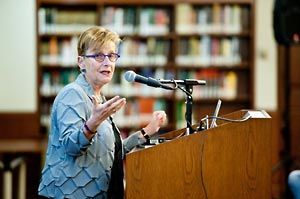“Small acts of repair” Yom Hashoah scholar-in-residence discusses postmemory of the Holocaust

Hirsch was born in Romania, and her own parents are survivors of the Romanian Holocaust from Czernowitz. “During my childhood in Romania, my parent’s Holocaust stories were a daily narrative, and in their view, it was not so bad,” she says. “But as I learned more, I realized that they weren’t telling the whole story. There was a certain moment around 1986—I started talking to friends, and realized that our parents’ memories had this quality, this texture that made them more real to us than our own memories.”
According to Hirsch, postmemory is experienced through exposure to stories, images and behaviors: “layers of mediation” that distance children of survivors from what their parents experienced. Citing the second-generation character in Art Spiegelman’s Pulitzer Prize-winning graphic novel Maus (1986) as an example, Hirsch describes how “you want to know everything… It could have been me, but it wasn’t me.”
I started talking to friends, and realized that our parents’ memories had this quality, this texture that made them more real to us than our own memories
The "Public Archive" as Postmemory
Maus also provides an example of how the “public archive” means postmemory can be something anyone can experience—not only the children of survivors. Hirsch recalls a childhood friend who came to identify with Anne Frank after portraying her in a school play; though her friend was not a child of survivors, postmemory—affiliative in this case, as opposed to familial—made the Holocaust part of her experience just the same.
The day after her lecture, Hirsch discussed postmemory in further detail at the USC Shoah Foundation. “The way it comes down to us through an interaction between two people, like the bedtime stories in Maus…is not just in words. It’s in the language of the body, it’s in the room. Video has that quality.”